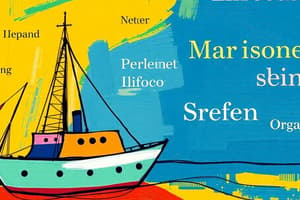Podcast
Questions and Answers
What is the primary purpose of using Standard Maritime Communication Phrases (SMCP) in maritime communication?
What is the primary purpose of using Standard Maritime Communication Phrases (SMCP) in maritime communication?
- To minimize ambiguity and bridge language barriers for clear understanding of critical information. (correct)
- To showcase the speaker's proficiency in multiple languages.
- To ensure efficient social interactions among crew members.
- To allow faster communication, even if precision is sacrificed.
Which communication channel is most suitable for establishing contact with a vessel located thousands of nautical miles away?
Which communication channel is most suitable for establishing contact with a vessel located thousands of nautical miles away?
- MF/HF radio
- Satellite communication (correct)
- VHF radio
- Navigational Telex (NAVTEX)
In a distress situation, what information is crucial to include when transmitting a 'MAYDAY' message?
In a distress situation, what information is crucial to include when transmitting a 'MAYDAY' message?
- The latest stock market updates.
- The vessel's name, position, and nature of distress. (correct)
- The menu for the next meal.
- The current sports scores.
Why is it important to adhere to established communication protocols in maritime operations?
Why is it important to adhere to established communication protocols in maritime operations?
What is the significance of the Automatic Identification System (AIS) in maritime safety?
What is the significance of the Automatic Identification System (AIS) in maritime safety?
Which statement accurately describes the role of Digital Selective Calling (DSC) within the Global Maritime Distress and Safety System (GMDSS)?
Which statement accurately describes the role of Digital Selective Calling (DSC) within the Global Maritime Distress and Safety System (GMDSS)?
When should the urgency signal 'PAN PAN' be used?
When should the urgency signal 'PAN PAN' be used?
What is the purpose of initiating a message with 'SECURITY' in maritime communication?
What is the purpose of initiating a message with 'SECURITY' in maritime communication?
Which of the following is NOT a typical challenge encountered in maritime communication?
Which of the following is NOT a typical challenge encountered in maritime communication?
Why is it important to maintain accurate communication logs on board a vessel?
Why is it important to maintain accurate communication logs on board a vessel?
Flashcards
Maritime Communication Protocols
Maritime Communication Protocols
A set of rules for exchanging information, ensuring reliable, timely, and secure communication.
Ship-to-ship communication
Ship-to-ship communication
Direct communication between vessels.
Ship-to-shore communication
Ship-to-shore communication
Communication between a vessel and a land-based station.
VHF Radio Communication
VHF Radio Communication
Signup and view all the flashcards
Digital Selective Calling (DSC)
Digital Selective Calling (DSC)
Signup and view all the flashcards
Automatic Identification System (AIS)
Automatic Identification System (AIS)
Signup and view all the flashcards
Global Maritime Distress and Safety System (GMDSS)
Global Maritime Distress and Safety System (GMDSS)
Signup and view all the flashcards
MAYDAY
MAYDAY
Signup and view all the flashcards
PAN PAN
PAN PAN
Signup and view all the flashcards
SECURITY
SECURITY
Signup and view all the flashcards
Study Notes
- Maritime English ensures clear communication among diverse linguistic backgrounds within the maritime industry.
- It is vital for maritime safety, operational efficiency, and effective coordination.
Importance of Maritime English
- Prevents accidents, injuries, and environmental damage resulting from miscommunication.
- Supports effective communication during critical emergency scenarios.
- Aids in adhering to international maritime regulations and set standards.
- Boosts operational efficiency and minimizes potential delays.
- Fosters a secure working environment for all seafarers.
Key Features of Maritime English
- Employs standardized vocabulary and grammar to reduce potential ambiguity.
- Leverages use of Standard Maritime Communication Phrases (SMCP).
- Prioritizes clarity, brevity, and precision in communication.
- Steers clear of colloquialisms, idioms, and jargon to ensure universal understanding.
- Incorporates specific phonetic alphabets and numeral pronunciation for accuracy.
Standard Maritime Communication Phrases (SMCP)
- IMO developed standard phrases, designed for essential communication at sea.
- SMCP covers navigation, maneuvering, safety, and distress situations.
- SMCP bridges language gaps, ensuring mutual understanding of critical information.
- Mandatory on all ships and shore-based authorities for consistent communication.
Communication Protocols
- Protocols are sets of rules ensuring reliable, timely, and secure information exchange.
- Maritime protocols govern message transmission, reception, and interpretation.
Types of Maritime Communication
- Ship-to-ship communication allows direct communication between vessels.
- Ship-to-shore communication is between vessels and land stations like port authorities or coast guards.
- Shore-to-ship communication involves land stations communicating with vessels.
- Onboard communication facilitates coordination among crew members on a vessel.
Communication Channels
- VHF radio is the primary short-range communication method at sea.
- MF/HF radio enables long-range maritime communication.
- Satellite communication offers global coverage via satellite networks.
- NAVTEX is an automated service for broadcasting navigational and meteorological warnings.
- DSC sends digital distress alerts and important messages.
- AIS to transmits vessel identity, position, course, and speed.
VHF Radio Communication
- Most common method for short-range communication at sea (up to 30 nautical miles).
- Uses specific channels for distress (Channel 16) and inter-ship communication (Channel 6).
- Proper radio procedures and adherence to regulations is required.
- Primarily voice communication, with data transmission capabilities.
MF/HF Radio Communication
- Used for long-range communication covering hundreds/thousands of nautical miles.
- Frequencies vary based on distance and atmospheric conditions.
- Supports voice, telex, and data transfer with specialized equipment and trained personnel.
Satellite Communication
- Offers global coverage anywhere via geostationary or LEO satellites.
- Services include voice, data, and internet access.
- Vital for long-distance communication, weather updates, and telemedicine services.
Digital Selective Calling (DSC)
- Sends digital distress alerts and safety messages, including vessel identity/position.
- Selective calling allows communication with specific vessels or groups.
- DSC integrates with the Global Maritime Distress and Safety System (GMDSS).
Automatic Identification System (AIS)
- AIS transponders automatically transmit vessel data to ships and shore stations.
- Provides real-time data which includes identity, position, course, and speed.
- It enhances situational awareness and aids in collision avoidance.
- Mandatory for many vessels under the International Convention for the Safety of Life at Sea (SOLAS).
Global Maritime Distress and Safety System (GMDSS)
- GMDSS ensures distress alerts are promptly sent/received using satellite and terrestrial tech.
- Vessels must carry specific communication equipment based on their operational area.
- It represents an international system for maritime distress and safety communication.
Communication Procedures
- Use clear/concise language and speak slowly/distinctly.
- Use phonetic alphabet when spelling words.
- Verify recipient identity before sharing sensitive information.
- Adhere to established communication protocols and maintain listening watch on channels.
Distress Communication
- Use "MAYDAY" to indicate distress, then state vessel name, position, and nature of distress.
- Include relevant information like people on board and assistance needed.
- Continue transmitting until acknowledged.
Urgency Communication
- Use "PAN PAN" to indicate urgency, then state vessel name, position, and situation.
- Include any helpful information.
Safety Communication
- Used for transmitting information about navigational hazards and weather warnings.
- Begin with "SECURITY" and state the hazard/warning and its location.
Challenges in Maritime Communication
- Language barriers among different linguistic backgrounds can cause misunderstandings.
- Technical malfunctions or signal interference can disrupt communication efforts.
- Weather and sea conditions can also affect radio signal propagation.
- Human errors can lead to serious consequences from miscommunication.
- Cyber attacks represent a growing threat that can infiltrate and compromise systems.
Best Practices for Maritime Communication
- Use Standard Maritime Communication Phrases (SMCP) when possible.
- Maintain a command of Maritime English and regularly test communication equipment.
- Train crew in communication procedures, use clear language, and follow established protocols.
- Be aware of potential challenges and maintain accurate communication logs.
- Implement cybersecurity measures to protect communication systems.
Studying That Suits You
Use AI to generate personalized quizzes and flashcards to suit your learning preferences.




